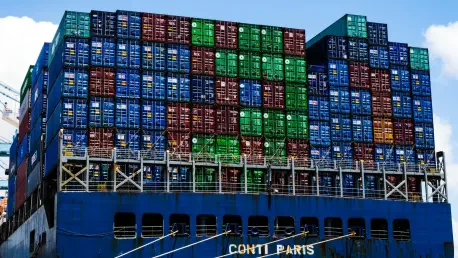As global manufacturers swiftly adjust supply chain strategies in response to a variety of geopolitical uncertainties and trade complexities, they inadvertently open doors to potential cyber threats. This period of transformation is marked by the integration of new suppliers and systems, each presenting fresh opportunities for cybercriminals looking to exploit vulnerabilities. Malicious actors, ranging from sophisticated state-backed groups to opportunistic ransomware gangs, closely monitor these shifts, aiming to access sensitive information or set the stage for disruptive future attacks. While businesses concentrate on navigating logistical challenges and compliance mandates, cyber risks can quietly proliferate, posing substantial threats to digital and operational stability. Understanding these evolving risks associated with cyber threats in supply chains becomes paramount for manufacturers determined to safeguard their operations and maintain digital trust with vendors, akin to ensuring operational reliability.
Emergence of Digital Supply Chains
Today’s supply chains encompass more than physical logistics; they are intricately interwoven with digital processes, requiring vigilant attention to cybersecurity. The proliferation of software supply chain compromises, as demonstrated in cases like SolarWinds, MOVEit, and 3CX, underscores the potential for malicious code inserted during ordinary updates to trigger extensive repercussions. In such an interconnected environment, a vendor’s digital trust becomes as critical as their operational capabilities. Unfortunately, as companies prioritize rapid onboarding of suppliers—often under immense pressure and with limited visibility—they inadvertently create blind spots that cyber attackers can exploit. The expansion of the digital footprint, through ERP integrations, cloud production systems, remote access points, and EDI portals, serves to widen attack surfaces. State-affiliated threat groups, such as China’s APT41 and Russia’s FIN7, repeatedly leverage these vendor relationships to move laterally, exploiting valid credentials and remote services, underscoring the urgency for disciplined provisioning, auditing, and deprovisioning practices.
Oversight in Cyber Due Diligence
Despite an uptick in cyber threats, many manufacturers fall short of establishing formal processes for scrutinizing the cybersecurity measures of prospective suppliers. Essential inquiries, including the use of multi-factor authentication (MFA) or encryption of sensitive files by vendors, often remain unaddressed. This oversight paved the path for incidents like the Target breach, where attackers gained a foothold through compromised credentials—with feeble security controls—of a third-party HVAC vendor. This breach resulted in extensive financial losses, highlighting the necessity for vendors to prioritize cybersecurity evaluations alongside considerations for production quality and financial soundness when expanding into new regions. Regional variances in cybersecurity maturity can further compound risks, necessitating meticulous vetting of suppliers’ digital hygiene practices. Manufacturers must integrate cybersecurity due diligence into their strategic assessment of suppliers, treating it as a fundamental aspect of supplier evaluations rather than an optional consideration.
Risks in Data Sharing Practices
During transitions in supply chains, premature data sharing often occurs before robust IT integrations are established with new partners, leaving sensitive information vulnerable to theft and interception. Expedience, favoring swift operations, frequently surpasses security concerns in these instances, resulting in risky practices like transmitting critical documents via unsecured email or file-sharing tools lacking adequate protections. Cases such as Norsk Hydro’s ransomware attack, which exposed substantial deficiencies in file access controls across production systems, and the MOVEit Transfer breach in Shell’s Australian subsidiary emphasize the dire consequences of inadequate security in data sharing protocols. Additional risks arise from legacy connections to former vendors, where VPN tunnels, API tokens, ERP interfaces, and shared environments remain active long after contractual relationships end. Known as “ghost” connections, these unmonitored entry points, alongside “zombie” accounts of ex-employees, persist due to inadequate password policies and deficient deprovisioning procedures, providing cybercriminals unnoticed access over prolonged periods.
Addressing Communication Gaps in Supply Chains
Periods of supply chain shifts frequently lead to communication gaps, elevating the risk of impersonation attacks such as business email compromise (BEC), phishing, and deepfake scams. Such vulnerabilities intensify during vendor transitions or crisis responses, exacerbated by the reduction in physical verification due to remote and hybrid work models. Attackers often counterfeit supplier domains to dispatch fraudulent invoices, reroute shipments, or steal login credentials, particularly during onboarding phases or payment processes. Noteworthy incidents like Leoni AG’s loss of €40 million due to spoofed executive emails and Toyota Boshoku’s financial losses from a counterfeit supplier payment request emphasize the need for strengthened communication protocols. Establishing secure communication channels and verifying vendor credentials can aid in minimizing the risks associated with these scams, but manufacturers need to proactively address these vulnerabilities within broader cybersecurity strategies.
Strategies for Mitigating Threats
To fortify supply chain security, it is imperative that manufacturers integrate cybersecurity considerations early and consistently within strategic planning. Incorporating cybersecurity parameters into supplier selection decisions, alongside financial and operational evaluations, stands crucial in reducing blind spots. Establishing clear inventory and management practices for digital connections between suppliers ensures controlled access points, with rigorous procedures governing both the onboarding and offboarding phases. Moreover, devising comprehensive vendor response playbooks—including breach notification timelines, access revocation guidelines, and escalation procedures—can significantly aid companies in promptly addressing any vendor compromise. Embedding these expectations within contractual agreements and service level agreements (SLAs) ensures that supply chain cybersecurity remains a prioritized agenda. Manufacturing, procurement, and IT teams must collaborate seamlessly, engaging in regular evaluations and cultivating a proactive approach to cybersecurity within supply chains to thwart potential vulnerabilities before they escalate into significant threats.
Navigating the Path Forward
As global manufacturers rapidly modify supply chain strategies to address various geopolitical uncertainties and trade challenges, they unintentionally expose themselves to potential cyber threats. This transformation involves integrating new suppliers and systems, each presenting unique opportunities for cybercriminals eager to exploit any vulnerabilities. These malicious actors, ranging from sophisticated, government-backed entities to opportunistic ransomware gangs, carefully observe these changes to gain access to confidential information or plan future disruptive attacks. Businesses focus on tackling logistical issues and compliance requirements, but cyber risks can quietly escalate, posing significant threats to both digital security and operational stability. Recognizing these ongoing risks related to supply chain cyber threats is crucial for manufacturers striving to protect their operations and maintain digital trust with their partners. Ensuring digital and operational reliability becomes as important as maintaining secure relationships with vendors in this evolving landscape.









